Driving Confessions

Admit it –- you’ve done some pretty unusual (and possibly risky) things in the car when you didn’t think anyone was looking. And guess what? It’s not just you. To find out what happens in cars, we asked more than 2,000 drivers across the United States to come clean about their behind-the-wheel habits.
What happens in your vehicle doesn’t stay in your vehicle. People ‘fessed up about anything and everything: from wacky habits, such as putting on deodorant to riskier behavior -– drinking and texting. They also tackled some tough questions and steered through difficult hypothetical situations about hitting animals, picking up hitchhikers and more.
Which generations, regions and vehicle-type owners have the most unusual habits? Keep reading to get the scoop on drivers’ biggest secrets.
Shocking Habits of Drivers in Moving Vehicles
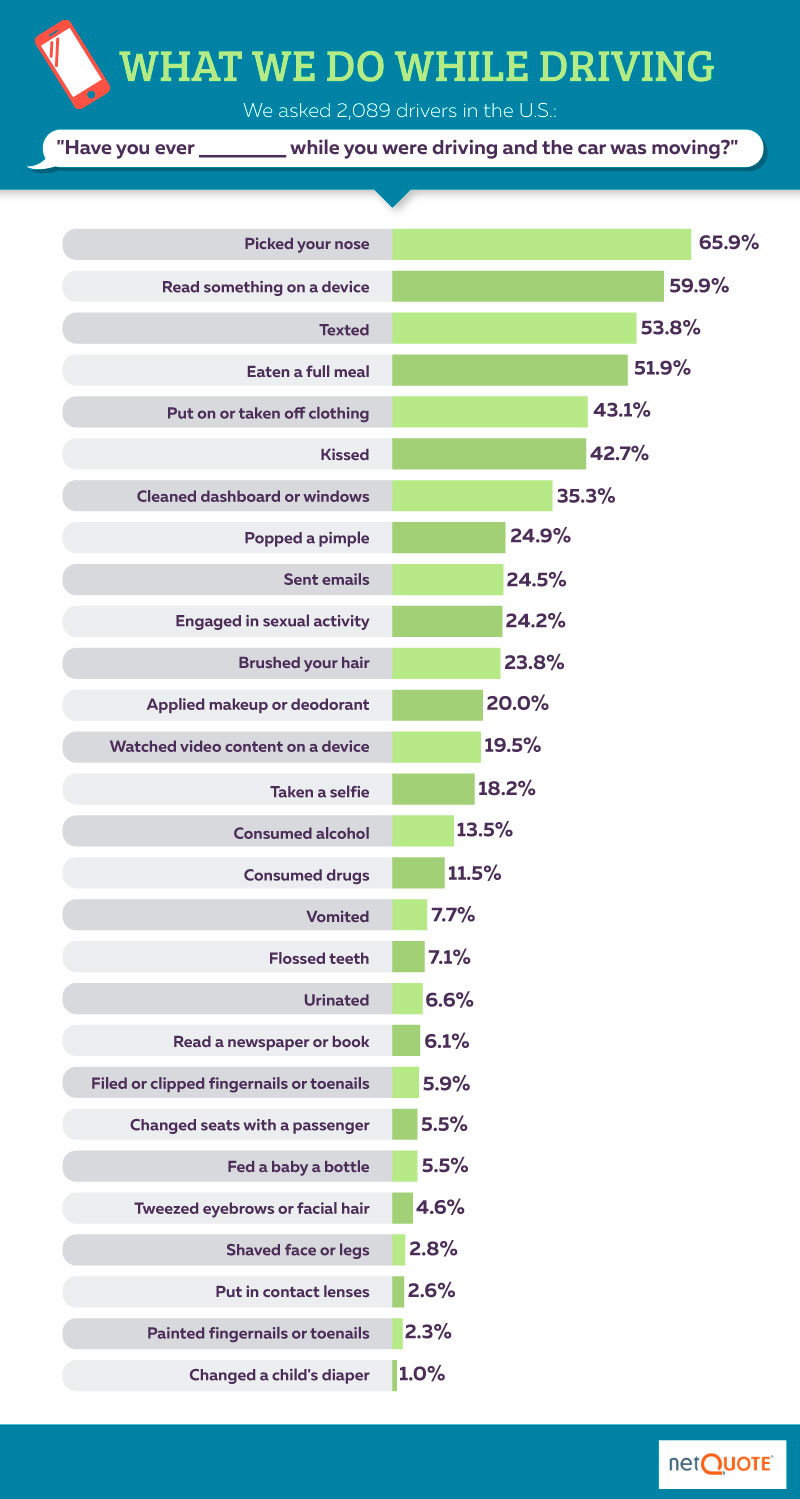
Distracted driving is a huge issue facing Americans today. But the types of activities that draw drivers’ attention away from the road aren’t necessarily what you might expect. Among the most common ways drivers multitask in a moving vehicle? Personal hygiene, romance, reading and eating dominate the list.
Nearly two-thirds of drivers admit they have picked their noses, while more than 43 percent have changed their clothing, nearly a quarter have popped a pesky pimple or brushed their hair, and one-fifth have applied makeup. More than 7 percent have flossed their teeth, around 6 percent have clipped their nails and almost 3 percent have shaved their face or legs.
About 6 in 10 admit they’ve read (on a phone or other device) while operating a moving vehicle, and just more than half confess they’ve sent texts. More than half of people have eaten a full meal while driving and around 43 percent admit they’ve shared a kiss. From the shocking files: Nearly a quarter have engaged in sexual activity, almost 14 percent have consumed alcohol, nearly 12 percent have taken drugs, nearly 8 percent have vomited and almost 7 percent have urinated.
Dangerous Driving Habits
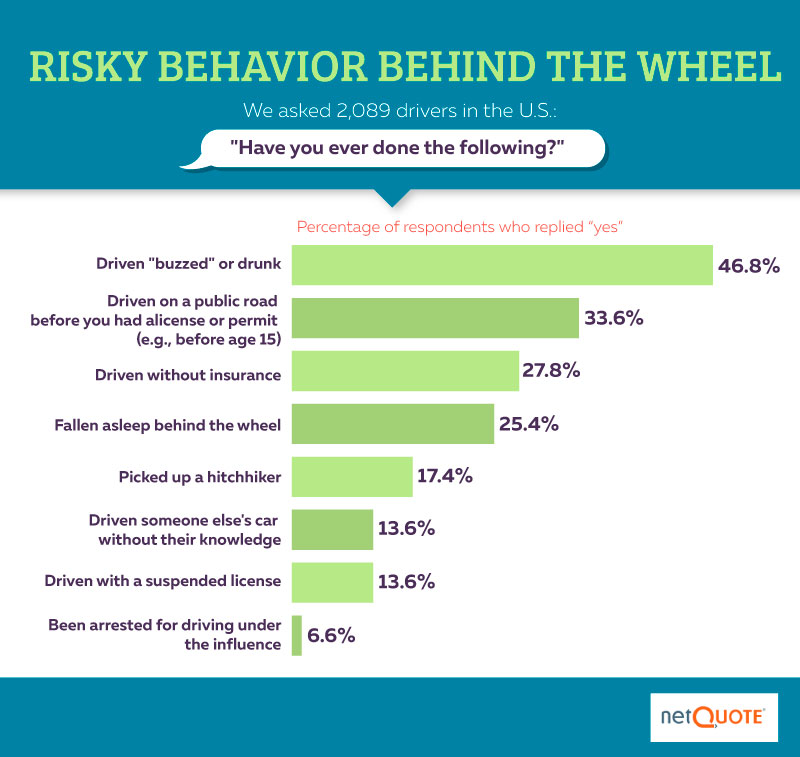
Some driving habits are riskier than others. The most common dangerous behavior? Driving while drunk or “buzzed,” which nearly half of our survey respondents admit they have done. Though this figure seems high, perhaps it shouldn’t come as a surprise: In 2014, people who died in alcohol-related crashes comprised one-third of all traffic-related deaths in the United States.
Additionally, around one-third of people admit they’ve operated a vehicle before obtaining their license, and another 28 percent say they’ve driven while uninsured.
Shockingly, more than a quarter admit they’ve fallen asleep while behind the wheel. Other risky behaviors people copped to include picking up a hitchhiker, “borrowing” someone else’s car and driving with a suspended license.
Drunk Driving by Generation and Region
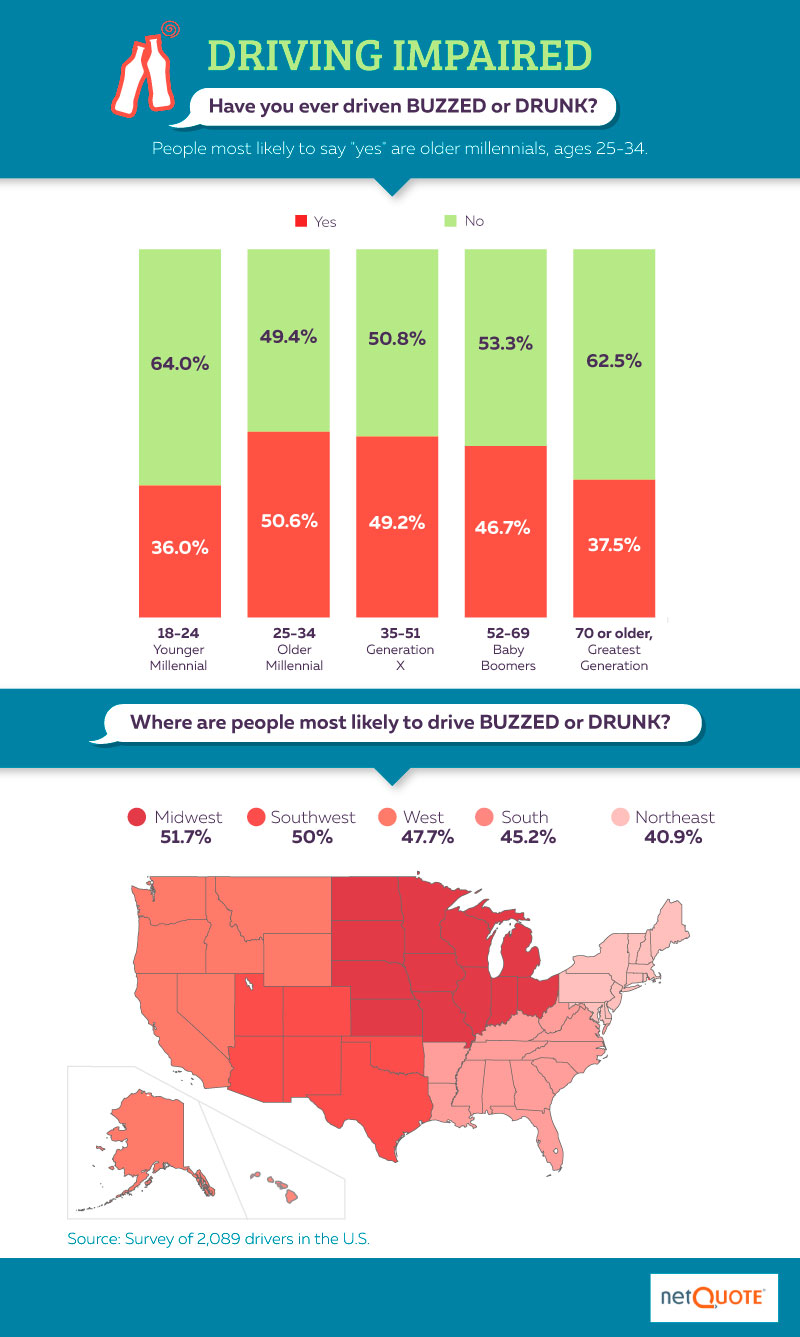
To find out who’s likeliest to get behind the wheel after drinking, we took a closer look at the ages and locations of respondents who confessed to driving buzzed or drunk. Older Millennials (age 25 to 34) are the most likely to drive drunk, with nearly 51 percent admitting they have.
Generation Xers (ages 35 to 51) come in a close second at just more than 49 percent, followed by Baby Boomers (ages 52 to 69) at nearly 47 percent. Younger Millennials (ages 18 to 24) are least apt to drive while under the influence, with the Greatest Generation (age 70-plus) taking a close second.
Our respondents’ drinking and driving habits vary by region as well. Drivers in the Midwest are most likely to operate a car after drinking –- nearly 52 percent of our Midwestern survey participants said they’d done so. The Southwest is second for drinking and driving, with 50 percent saying they had. On the other end, just less than 41 percent of our Northeastern respondents confessed to the dangerous act.
Vehicle Type and Texting Habits
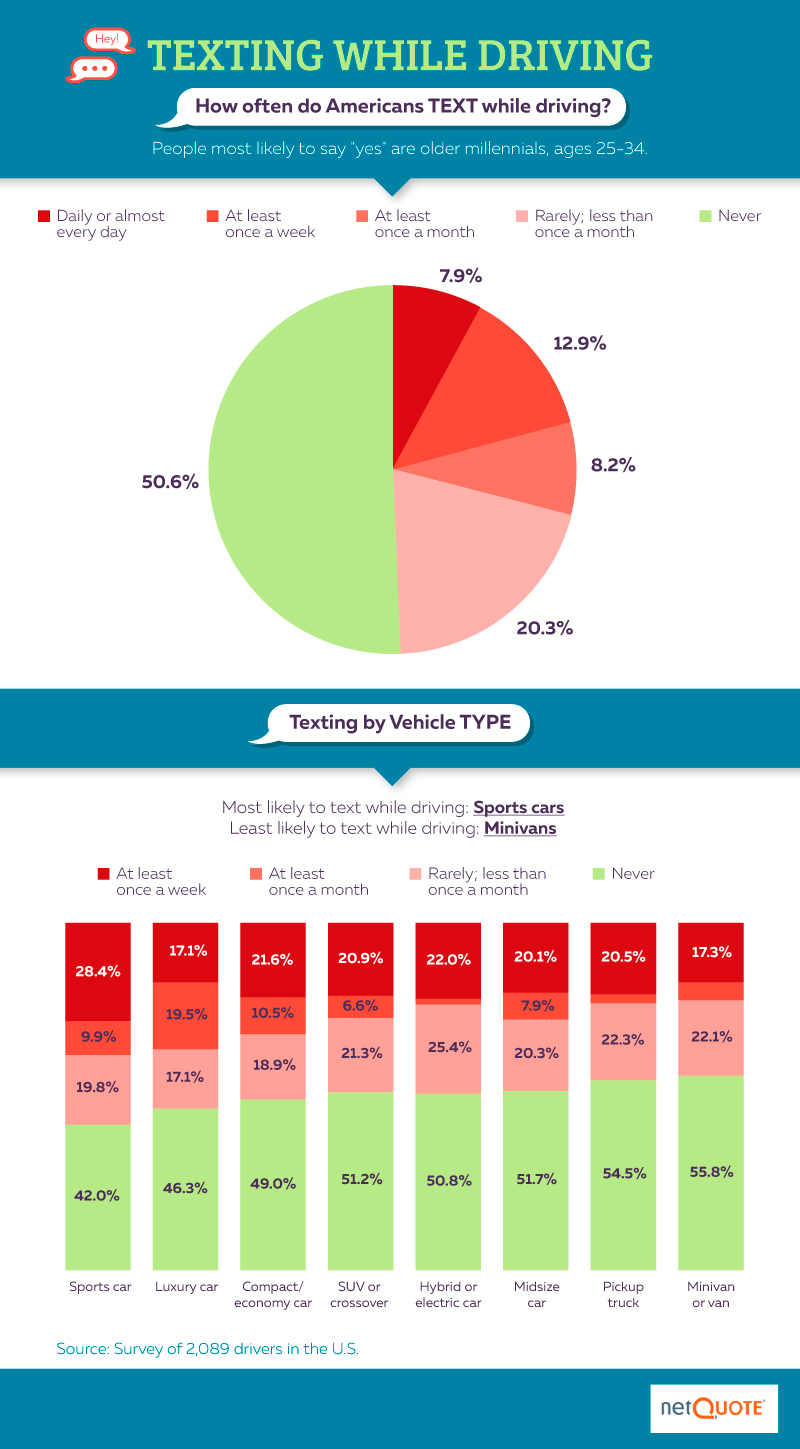
Among all distracted driving habits, texting is among the most disturbing because it requires a driver’s full attention –- and their hands, eyes and mind are all focused on their device.
Among our respondents, just over half say they’ve never texted while driving. On the other hand, nearly 8 percent say they text and drive daily. Just over 8 percent admit to doing it once a month,nearly 13 percent do so once a week, and over 20 percent admit they do so rarely.
Intriguingly, people who drive certain types of cars may be more likely to text while they’re behind the wheel. Over 28 percent of sports car drivers admit they text and drive daily -– and only 42 percent say they’ve never done so. On the other hand, only 17.3 percent of people who drive minivans or vans say they do so daily, and 56 percent say they never have.
Texting and Driving Across the Country
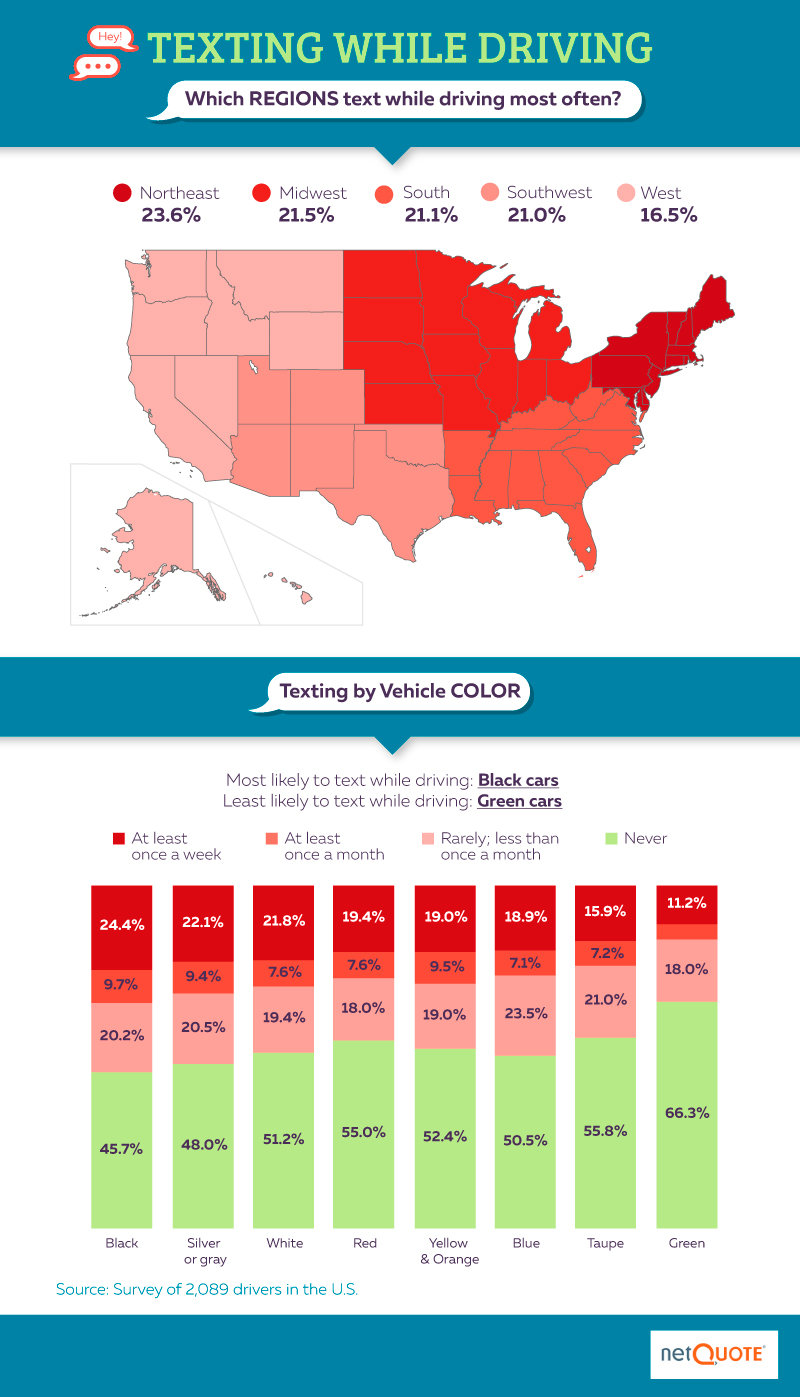
Who admits to texting and driving at least once a week? Nearly a quarter of Northeastern drivers confess to the dangerous habit. The Midwest, South and Southwest vie for second place, with around onefifth of drivers saying they text and drive. On the bottom, only 16.5 percent of drivers in the West say they text behind the wheel once a week or more.
Color may play a role as well. Only 11.2 percent of people who drive green cars say they text and drive every day –- and two-thirds say they’ve never sent text messages from behind the wheel. On the other hand, nearly a quarter of people who drive black cars reveal they text and drive daily, and only around 46 percent say they’ve never.
How Do the Genders Compare?
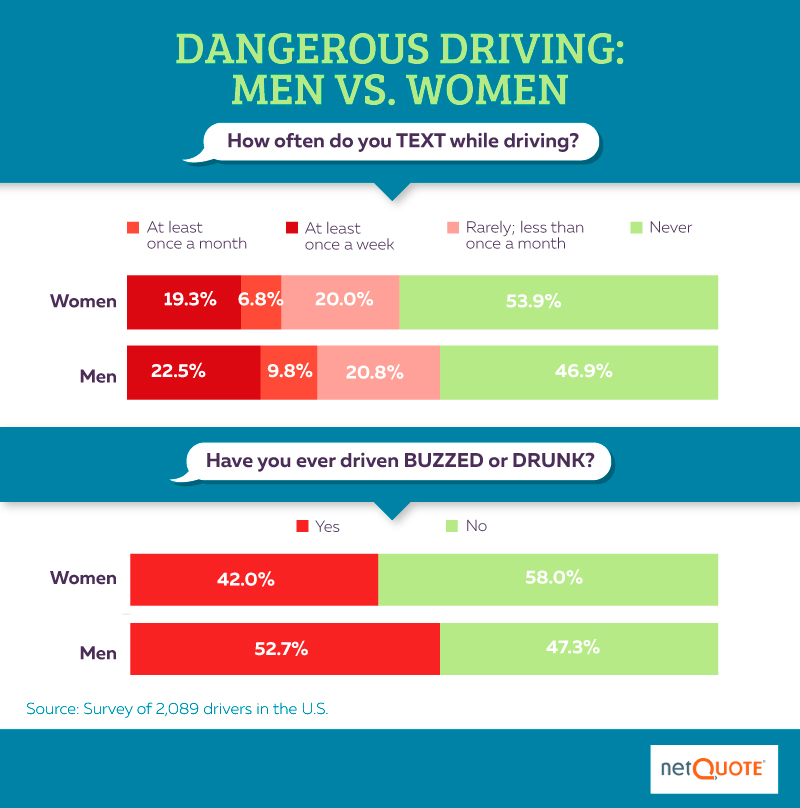
It’s the ageold debate – when it comes to safe driving habits, do men or women come out on top? Our survey may not settle the score entirely, but it reveals some interesting insights. On the topic of drinking and driving, women win: Only 42 percent of our female survey respondents say they’ve driven drunk or buzzed, while nearly 53 percent of men said they have.
When it comes to texting and driving, the message is the same: Nearly 54 percent of women say they have never sent a message from the driver’s seat, while only around 47 percent of men say the same. Additionally, nearly 23 percent of men say they text and drive every week,and just over 19 percent of women do.
Real-Life Driving Scenarios Revealed
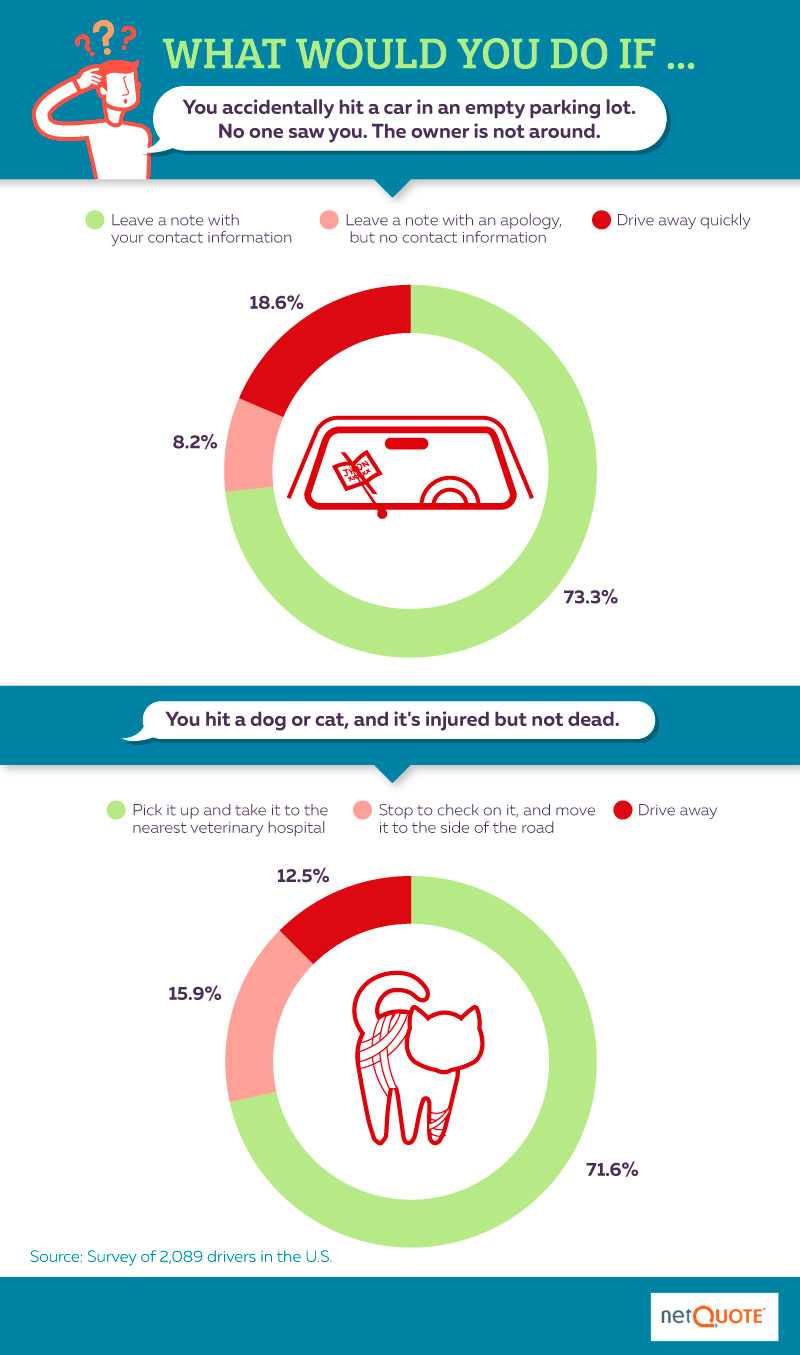
We also posed some difficult questions for our survey respondents regarding how they’d handle hypothetical situations. If our respondents hit a parked car and no one witnessed it, almost three-quarters said they’d leave a note with their contact information. However, nearly 19 percent would flee the scene.
If our respondents hit and injured an animal while driving, nearly 72 percent say they’d bring the hurt animal to the closest vet. Sadly, almost 13 percent would simply drive away –- and nearly 16 percent would stop to move the injured animal to the side of the road.
Would You Pick Up This Hitchhiker?
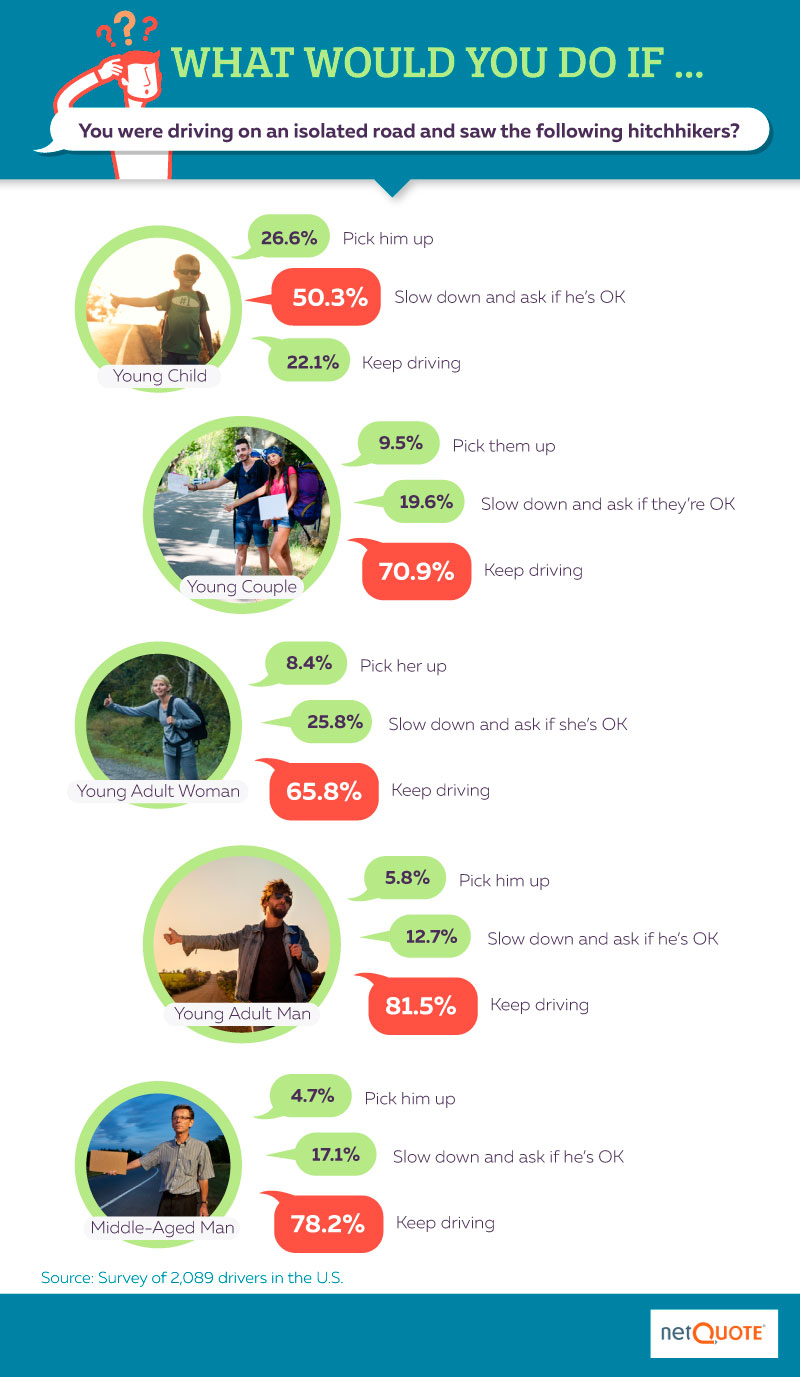
Finally, we showed respondents a series of photographs depicting fictional hitchhikers and posed three questions: Would you pick this person up, slow down and ask if they’re okay, or keep driving?
The child had the best odds of being picked up. However, although nearly 27 percent say they’d give the young boy a ride, over 22 percent would keep driving, while just over half would slow to check on his wellbeing. The young couple had the secondbest chance of catching a ride, followed closely by the young woman.
On the other hand, the older, slightly disheveled businessman had the worst odds of getting a ride: Fewer than 5 percent of people would pick him up, and over 78 percent would simply keep driving. The younger bearded man clad in jeans was slightly more likely to get a ride, as nearly 6 percent of people say they’d pick him up. However, people were more likely to slow down and check on the businessman rather than simply drive away.
Conclusion
The visual of a driver changing a diaper or clipping their nails while behind the wheel may bring a smile to your face. But in reality, dangerous driving habits are no laughing matter – and their consequences can be deadly. As our survey reveals, the number of Americans who take risks behind the wheel (including drunk driving and texting) is a staggering one.
And while some of these habits appear to vary by generation, region, and even type of car, theresult is the same: too many drivers engaging in risky behavior while they drive. The good news? You can spark change by taking responsibility for your own driving habits. Never drive distracted under any circumstances – if you need to send a text (or clip your fingernails), it’s easy to pull over. Never get behind the wheel after consuming alcohol. And when it comes to ethical questions – such as taking responsibility after injuring an animal or hitting a parked car –here’s a simple rule of thumb: Treat others the way you would like them to treat you.
Methodology
We surveyed 2,089 drivers in the U.S. between May 12 and May 15, 2016. Respondents were between the ages of 18 and 75 and came from all 50 states, plus the District of Columbia. They were 47.5% female and 52.5% male.
Sources
http://www.cdc.gov/motorvehiclesafety/impaired_driving/impaireddrv_factsheet.html
http://www.distraction.gov/statsresearchlaws/factsandstatistics.html
Fair Use
Feel free to share and publish any of these images. We just ask that you credit NetQuote.com and provide a link back to this page so your readers can find out more about our research.
